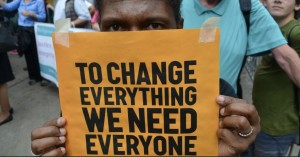Typically the entries for iePEDIA focus on narrow, technical terms in the hopes of expanding the general understanding of such terms. In this entry, we move to the very large stage to talk about a “climate movement.” While it can sound grandiose, there is a concrete dimension to the term.
With regard to environmental movements, the 19th and early 20th century often focused on conservation of natural resources and spaces, including parklands, and the supporters tended to be from the middle class. During and after the world wars, supplies for natural materials for products, e.g., rubber, were widely disrupted and artificial substances, typically chemical in nature, were used as substitutes. These materials included many toxic chemicals that were used, emitted into the air, and dumped into waters and land without much regulation or care. Identifying the toxicity of the chemicals and where they were dumped captured the attention of people caring about the environment in the 1950s to 2000. Many places where these materials were dumped were in communities of color and poor communities, so those involved in fighting for their health and environment came from a broader community. Many of the fights over environmental protection were also local in nature.
In the 21st century we have entered into a new era of a movement related to the environment, the “climate movement.” With the threats to climate from the usage of fossil fuels and the emission of greenhouse gases, especially carbon dioxide and methane, the movement is now global and affects us all — every one of us, not just the industrial community. We are all users and victims.
When the beginning of the climate movement became visible, through the efforts of James Hansen, Bill McKibben, Al Gore, others, and the earlier EU tough climate targets, there was an intensive push-back from the fossil fuel interests, and their supporters in the media and governments, to undermine efforts to combat climate change. But it seems fair tor say that the corner has turned and the consensus about human-induced climate change is broadly believed and endorsed. After an intensive effort by the scientific community, the media has abandoned its misguided policy of inviting a climate skeptic every time a climate scientist was invited. The recent People’s Climate March reflects much of this change. See current Commentary in irish environment magazine.
While the consensus is now established, the fight now is over who pays what for past, present, and future actions necessary to correct for the past climate abuses.
Some further ideas to explore on Climate Movement
Do you belong to any environmental organization?
Do you do any work for that organization?
Is your organization working with any other environmental organizations?
If not, try to determine what other environmental organization would be a good fit for what your group is doing.
Sources:
Todd Gitlin, “Why you should be hopeful about the climate movement,” in Commentary section of current issue of irish environment (Nov. 2014).
Sieren Ernst, “Did the “People’s Climate” March Leave Conservatives on the Sidelines?” theenergycollective (6 Oct 2014). theenergycollective.com/sierenernst/2018221/climate-movement-throwing-conservatives-under-bus
Robert Emmet Hernan, This Borrowed Earth: Lessons From the 15 Worst Environmental Disasters Around the World (Palgrave McMillan 2010; China Machine Press, 2011).



No comments yet, add your own below